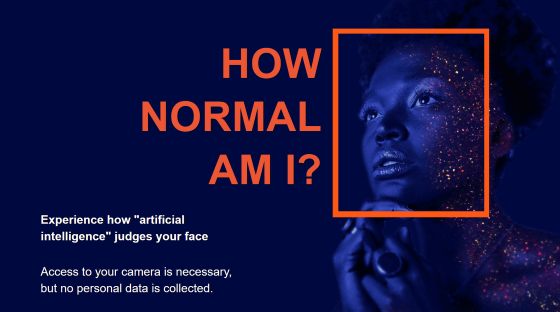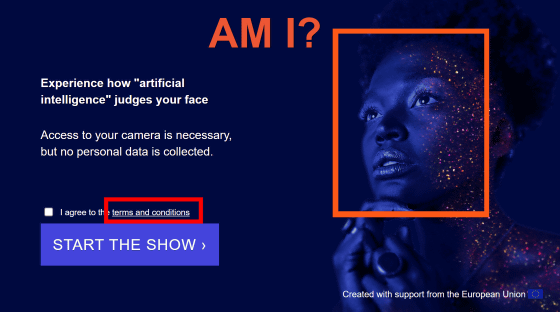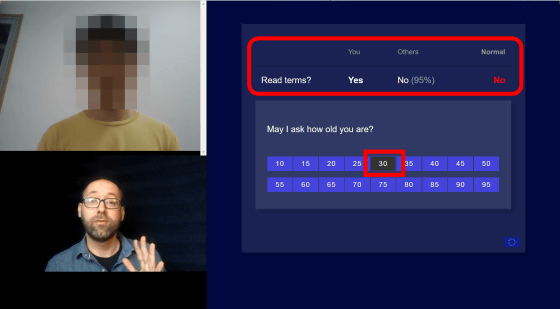'How normal am I?' That predicts attractiveness and lifespan just by taking a picture of your face with a camera.

In recent years, face recognition systems using AI have become widespread in various fields such as business and entertainment, but it is difficult to realize how face recognition systems work. Tijmen Schep, a member of
How normal am I?
https://www.hownormalami.eu/
How Normal Am I? – Tijmen Schep
https://www.tijmenschep.com/how-normal-am-i/
“How Normal Am I?” nominated for best .eu website of the year – Project Sherpa
https://www.project-sherpa.eu/how-normal-am-i-nominated-for-best-eu-website-of-the-year/
Project Sherpa is a consortium funded by the European Union (EU) to study the impact of AI and big data analysis on ethics and human rights, and 'How normal am I?' Was also created with an EU grant. That. 'How normal am I?' Is designed to raise your interest by actually experiencing the prediction of attractiveness, age, and BMI using a face recognition algorithm.
Below, I will review how I actually tried 'How normal am I?', But if you want to try it without prejudice, it is recommended to try it before reading the article.
When you access the top page of 'How normal am I?', 'Experience how' artificial intelligence 'judgment your face (experience how' artificial intelligence 'determines your face)' 'Access to your' camera is necessary, but no personal data is collected. '(Camera access is required, but personal data is not collected.)'

First of all, if you click 'terms and conditions' to read the terms of use ...

He praised me for trying to read the terms of service. In 'How normal am I?', No personal data is sent to the server, and the face recognition algorithm is executed in the browser of the computer. It also explains that the anonymized data is used for the average aggregation of 'How normal am I?', But no further anonymized data is shared.

After reading the terms of use, click 'START THE SHOW'.

Then, at the bottom left of the screen, a video explaining that Mr. Schep will not collect data will be displayed, asking for access to the camera. Click 'Allow' ...

The image taken by the camera is displayed in the upper left, and the loading of the face recognition algorithm starts. The image of the dog is displayed on the right side for some reason.

When the face recognition algorithm was activated, the 'percentage of people who read the terms of service' was displayed in the upper right corner. According to the data, 95% of the people are 'No', and it can be seen that the editorial staff who read it properly was on the side of 5%. Also, on the screen below, I was asked how old I was, so click the nearest '30'. If you don't want to answer, just click nothing.

Of the users who used 'How normal am I?' So far, 78% shared their age. In this way, your selections and evaluations and 'average answers and evaluations' are displayed together for various items, so you can know 'how normal you are?'.

After that, the attractiveness of the face is evaluated in the range of '0 to 10'. Since the displayed score is the maximum value and sometimes fluctuates during measurement, you will want to move the angle of your face to aim for a good score. In addition, most of the machine learning algorithms that evaluate the attractiveness of the face and other items are diverted from the 'pre-learned' ones found on GitHub.

Next, I will start measuring the age, but the lowest predicted age displayed this time is '30', which is slightly higher than the actual age of the editorial staff who tested it. According to Schep, the algorithm called

Gender was correctly identified as 'male'.

Subsequently, BMI prediction based on face recognition started, and during the measurement, it was wandering between '25 and 30'. However, the actual BMI of the editorial staff is about '19 to 20', which means that this prediction is far off.

In addition, the life span calculated based on BMI and age is '81 years old'. It seems that such life prediction is introduced in some parts of the insurance industry.

As a 'digital fingerprint of the face', a numerical value of each part of the face was also displayed.

Furthermore, it was revealed that the image of the dog that was initially shown was displayed to predict the 'feelings that the experiencer had on the dog.' It seems that the editorial staff had a 'sad' expression when the dog was displayed, but he was not aware of it.

During this evaluation, it seems that data on where the mouse cursor moved was also collected. 'You switched to another tab 10 times. Is it easy to get distracted?'

You will be asked if you want to include the anonymized data in the calculation of 'How normal am I?', So click 'OK' to allow it or 'NO' to deny it.

This completes the analysis of 'How normal am I?'. Finally, the result was 'You are 83% normal. It was violently normal.'

Related Posts:
in Review, Software, Web Service, Science, Posted by log1h_ik






